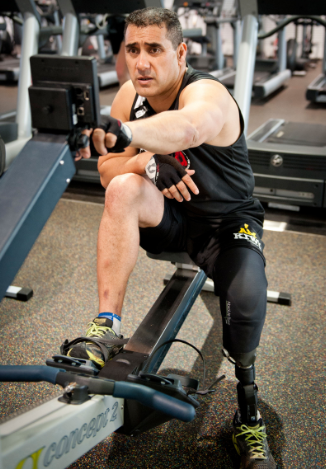
In 2003, I was deployed to Afghanistan with the NZSAS [New Zealand Special Air Service]. While on operation, I drove over a land mine, destroying the vehicle and sustaining serious injuries. The accident resulted in lower amputation to my left leg, fractures to my right leg and shrapnel to the left side of my body.
In order to adapt to my new life and sustain my drive to succeed beyond expectation, it was essential to acquire a robust, high-performance prosthetic. Like all good things, it didn’t happen overnight, but it did happen, and when I was eventually upgraded to my new state-of-the-art prosthetic I realized two things:
1) I succeeded in achieving my career goals without a high-tech prosthetic. My mind was not going to let me give up just because I didn’t have the flashiest prosthetic. It was hard, but there is no bending someone’s will to succeed when they are fully committed to it.
2) Before receiving my new prosthetic, I experienced severe discomfort from simply walking 10 metres, but I would “suck it up” and just get on with the job, thinking that no one could tell. But the truth is, my family always knew when I was in pain. I would try to hide it, but my pain made me grumpy and hard to be around sometimes. My new prosthetic has improved my quality of life in so many ways. I am not in pain anymore and I am happy, which makes my family happy.
This prosthetic improved my life in every way possible, for example, walking from 100metres to 5 kilometres overnight! Seriously, I got the new prosthetic one morning and ran 5 kilometres the next morning! I can now enjoy bush walks, mountain biking, kayaking and, more importantly, getting out of the house for some fresh air with the family.
These days I wear shorts, and I have a prosthetic that reflects who I am. It is strong, technically versatile and stylish (definitely me!). I show kids how amazing my prosthetic looks and their reaction and response is nothing but astonishment.
Rehabilitation wasn’t easy. I found the emotional part the most difficult — the feelings of helplessness and fear. As a big, strong guy, I worked hard all my life and took pride in my work and accomplishments. My initial journey tended to address the physical limitations and potential capabilities of an amputee. However, there was nothing in my rehabilitation plan to address my psychological or emotion state.
At the end of the day, I had to improve my quality of life by shifting my thinking from fear and doubt to becoming more optimistic about my future and opportunities.
I know that it was hard on my family. Being young and returning from deployment with a life-changing injury is a rollercoaster ride that no one wants to sign up for. We experienced the worst of each other and eventually the best of each other. The effect of a physical injury on one’s family should never be underestimated. It is tricky to navigate, but it can be done. Good people, good support and a “one day at a time” attitude is required. My family’s tools of choice are hope, love and forgiveness — these you will need bucket loads of.
A calculated career change was required. Striking a balance between education, upskilling and paying off a mortgage wasn’t as easy as we thought it would be. In fact, it was one of the hardest challenges in our lives, and was a journey of many ups and downs.
I’m happy to say we have stuck to a 10-year plan and are on track with our future. What an adventure it has been.


